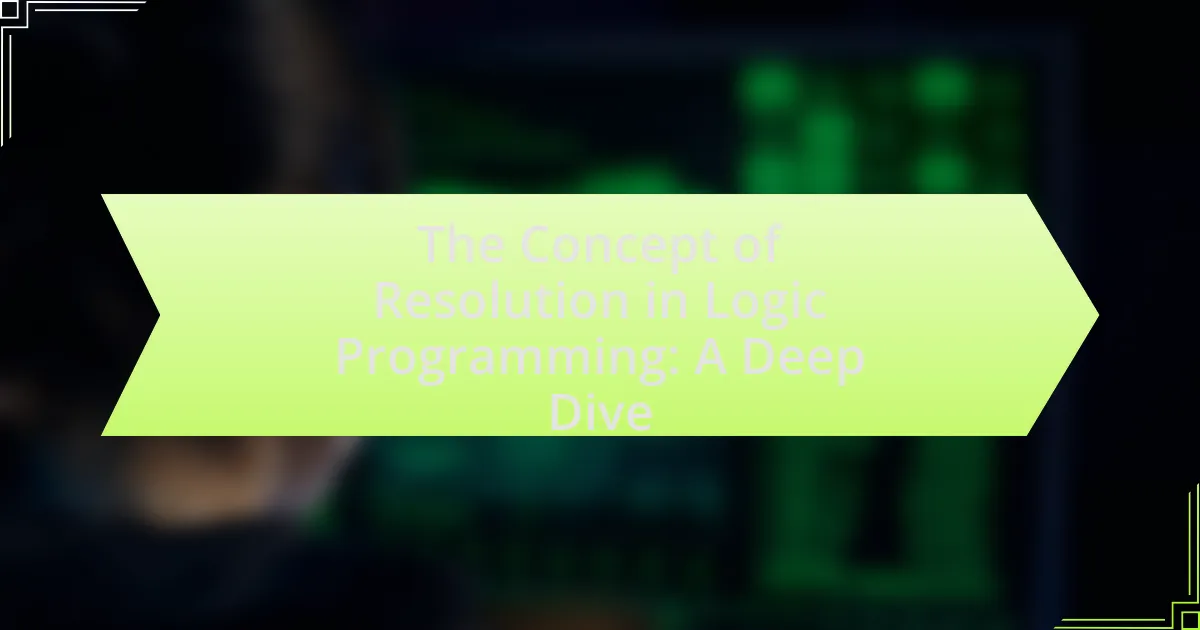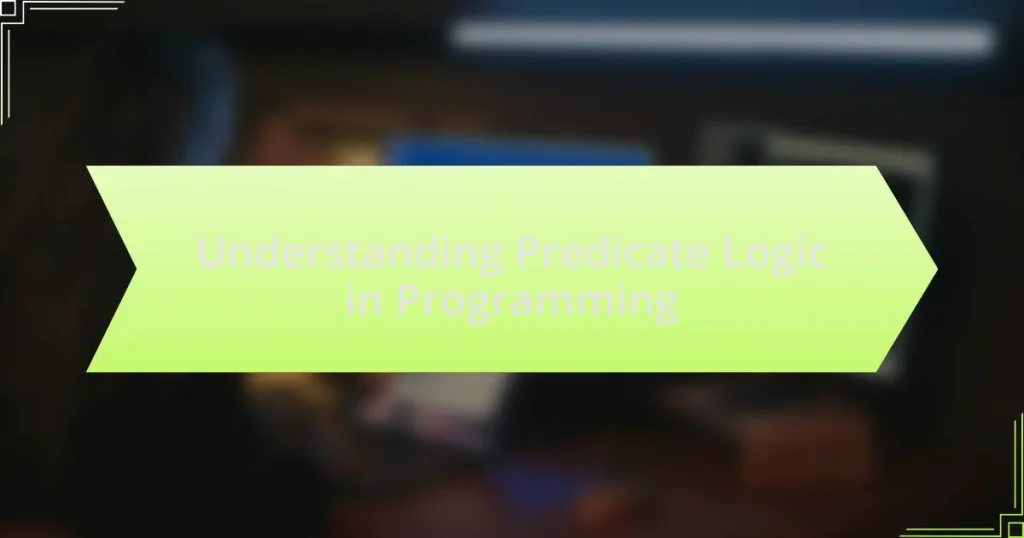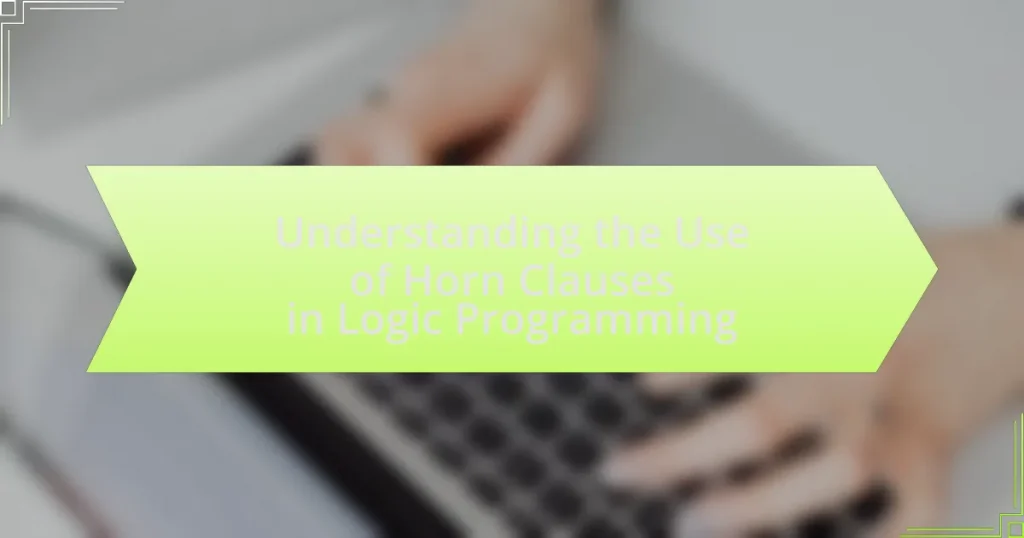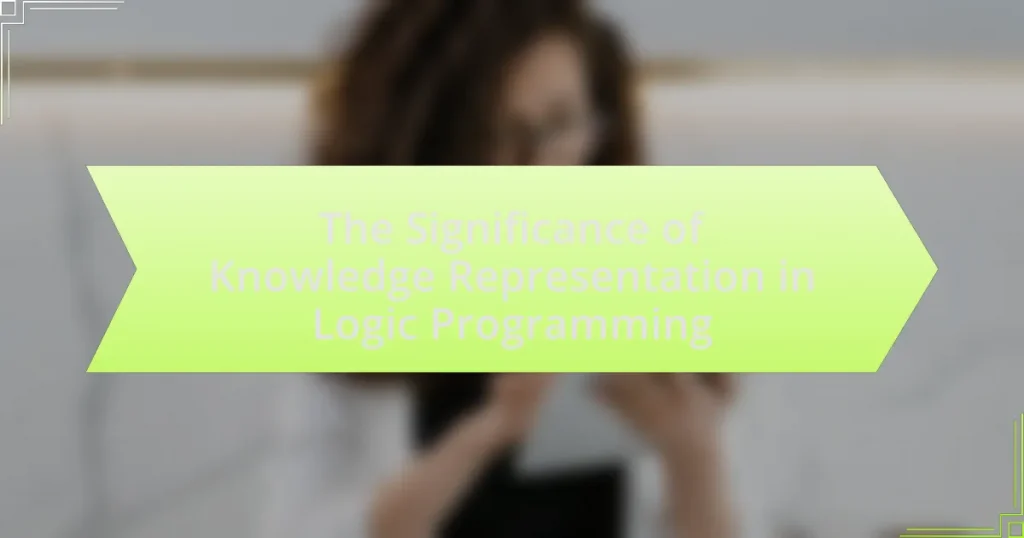The article focuses on the concept of resolution in logic programming, a fundamental rule of inference that allows for the derivation of conclusions from a set of premises in propositional and first-order logic. It traces the origins of resolution to John Alan Robinson’s work in 1965, highlighting its significance in automated theorem proving and logic programming languages like Prolog. Key components of the resolution process, including clauses, unification, and the resolution rule, are discussed, along with the advantages and limitations of resolution in problem-solving and knowledge representation within artificial intelligence. The article also explores future developments and best practices for implementing resolution effectively in logic programming.
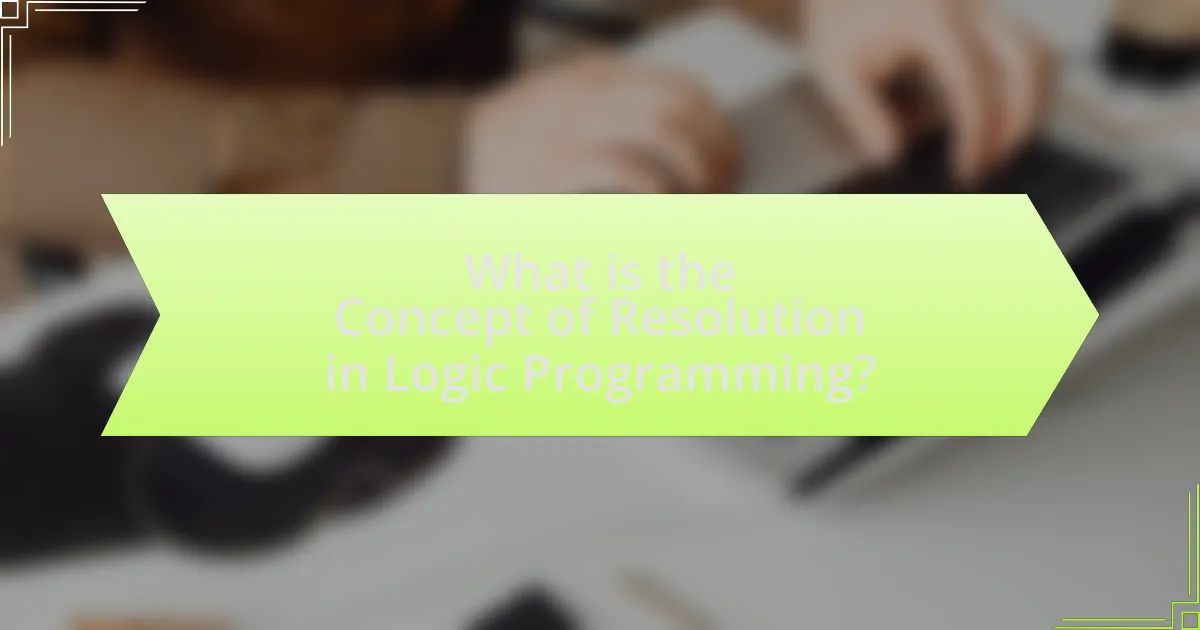
What is the Concept of Resolution in Logic Programming?
The concept of resolution in logic programming is a rule of inference used to derive conclusions from a set of premises. It operates on clauses in propositional logic or first-order logic, allowing for the derivation of new clauses by resolving pairs of clauses that contain complementary literals. This method is foundational in automated theorem proving and logic programming languages such as Prolog, where it facilitates the process of query resolution and knowledge representation. The validity of resolution is supported by its completeness and soundness properties, which ensure that if a conclusion can be derived, it is logically valid based on the initial premises.
How did the concept of resolution originate in logic programming?
The concept of resolution originated in logic programming through the work of John Alan Robinson in 1965, who introduced it as a method for automated theorem proving. Robinson’s resolution principle allows for the derivation of conclusions from a set of premises by refuting contradictions, thus forming the basis for logic programming languages like Prolog. This method relies on the transformation of logical statements into a standard form, enabling the systematic application of resolution to infer new information. The significance of Robinson’s work is underscored by its foundational role in the development of logic programming and artificial intelligence, establishing resolution as a key mechanism for reasoning in these fields.
What historical developments led to the formulation of resolution?
The formulation of resolution in logic programming was primarily influenced by the development of first-order predicate logic and the work of mathematicians and logicians in the mid-20th century. In 1965, John Alan Robinson introduced the resolution principle, which provided a complete method for automated theorem proving in first-order logic. This principle was built upon earlier work in propositional logic and the efforts of logicians like Kurt Gödel, who established the foundations of formal logic. Robinson’s resolution method allowed for the systematic derivation of conclusions from a set of premises, significantly impacting artificial intelligence and computational logic.
Who were the key figures in the development of resolution techniques?
The key figures in the development of resolution techniques include Alan Robinson, who introduced the resolution principle in 1965, and John McCarthy, who contributed to the foundations of artificial intelligence and logic programming. Robinson’s work established a formal method for automated theorem proving, which became a cornerstone of logic programming. McCarthy’s development of the Lisp programming language and his theories on formal reasoning significantly influenced the application of resolution techniques in AI. Their contributions laid the groundwork for modern logic programming and automated reasoning systems.
What are the fundamental principles of resolution?
The fundamental principles of resolution in logic programming are based on the concepts of unification and refutation. Resolution operates by deriving a contradiction from a set of clauses, allowing for the inference of new information. The process involves transforming statements into a standard form, typically conjunctive normal form (CNF), and applying the resolution rule, which states that if two clauses contain complementary literals, one can infer a new clause by combining the remaining literals. This method is foundational in automated theorem proving and is supported by the completeness theorem, which asserts that if a formula is logically entailed by a set of clauses, resolution can derive it.
How does resolution relate to first-order logic?
Resolution is a rule of inference used in first-order logic to derive conclusions from a set of premises. It operates by transforming logical statements into a standardized form, allowing for the systematic elimination of contradictions and the derivation of new clauses. The resolution process involves unifying predicates and applying the resolution rule to produce new clauses that can lead to a proof or disproof of a given statement. This method is foundational in automated theorem proving and logic programming, as it provides a mechanism for reasoning about logical statements in a structured manner.
What are the key components of the resolution process?
The key components of the resolution process in logic programming are clauses, unification, and the resolution rule. Clauses are disjunctions of literals that represent logical statements, while unification is the process of making different logical expressions identical by finding a substitution for their variables. The resolution rule combines two clauses to produce a new clause, which is a fundamental operation in deriving conclusions from premises. These components work together to facilitate automated theorem proving and reasoning in logic programming.
Why is resolution important in logic programming?
Resolution is important in logic programming because it serves as a fundamental inference rule that enables automated theorem proving and problem-solving. This method allows for the derivation of conclusions from a set of premises by transforming logical expressions into a standard form, facilitating the identification of contradictions. The significance of resolution is underscored by its ability to systematically eliminate variables and simplify complex logical statements, which is essential for the efficiency of logic programming languages like Prolog. Historical context shows that resolution was introduced by John Robinson in 1965, establishing a basis for many modern logic programming systems and proving its effectiveness in various applications, including artificial intelligence and formal verification.
What advantages does resolution provide in automated theorem proving?
Resolution provides a systematic and efficient method for automated theorem proving by transforming logical formulas into a standard form that facilitates inference. This advantage allows for the simplification of complex logical expressions, enabling the derivation of conclusions through a process of refutation. The resolution method is sound and complete, meaning that if a formula is unsatisfiable, resolution will eventually derive a contradiction, confirming the validity of the theorem. Additionally, resolution is particularly effective in first-order logic, where it can handle a wide range of logical constructs and quantifiers, making it a versatile tool in automated reasoning systems.
How does resolution enhance problem-solving capabilities in logic programming?
Resolution enhances problem-solving capabilities in logic programming by providing a systematic method for deriving conclusions from a set of premises. This technique allows for the transformation of logical statements into a standardized form, enabling automated reasoning processes. By applying resolution, logic programming systems can efficiently identify contradictions and validate the consistency of knowledge bases, which is crucial for solving complex problems. The effectiveness of resolution is evidenced by its foundational role in automated theorem proving and its implementation in various logic programming languages, such as Prolog, where it facilitates the inference of new information from existing facts and rules.
How does resolution connect to other logic programming concepts?
Resolution is a fundamental inference rule in logic programming that connects to other concepts such as unification, clauses, and the completeness of logical systems. It operates by deriving new clauses from existing ones, facilitating the process of proving theorems and solving problems within a logical framework. The connection to unification is critical, as resolution requires the identification of substitutions that make different clauses compatible, thereby enabling the derivation of conclusions. Additionally, resolution is integral to the completeness of first-order logic, as it guarantees that if a statement is logically entailed by a set of clauses, resolution can derive it, thus linking it to the broader principles of soundness and completeness in logic programming.
What role does unification play in the resolution process?
Unification is a critical mechanism in the resolution process of logic programming, as it allows for the matching of terms and the substitution of variables to derive conclusions from given premises. This process enables the identification of commonalities between different logical expressions, facilitating the derivation of new information by resolving queries against a knowledge base. For instance, in Prolog, unification is employed to determine whether a goal can be satisfied by a set of facts or rules, effectively linking disparate pieces of information to produce valid inferences.
How does unification facilitate the resolution of logical expressions?
Unification facilitates the resolution of logical expressions by allowing the identification of variable substitutions that make different logical expressions identical. This process is essential in logic programming, particularly in Prolog, where it enables the matching of goals with rules and facts. For instance, when a query is posed, unification systematically replaces variables in the query with corresponding terms from the knowledge base, thereby transforming the query into a form that can be resolved against existing facts or rules. This mechanism is crucial for deriving conclusions from premises, as it ensures that logical expressions can be manipulated to find common ground, ultimately leading to successful resolution of queries.
What challenges arise during the unification process?
Challenges during the unification process in logic programming include variable binding conflicts, type mismatches, and the need for efficient algorithmic implementation. Variable binding conflicts occur when two variables are assigned incompatible values, leading to failure in unification. Type mismatches arise when the types of terms being unified do not align, which can prevent successful resolution. Additionally, the efficiency of unification algorithms is critical, as inefficient implementations can lead to increased computational overhead, impacting the overall performance of logic programming systems. These challenges highlight the complexities involved in achieving effective unification in logical frameworks.

What are the applications of resolution in logic programming?
Resolution in logic programming is primarily applied in automated theorem proving, knowledge representation, and logic-based programming languages like Prolog. Automated theorem proving utilizes resolution to derive conclusions from a set of premises, enabling the verification of logical statements. In knowledge representation, resolution facilitates reasoning about facts and rules, allowing systems to infer new information from existing knowledge bases. Logic-based programming languages, such as Prolog, employ resolution as a fundamental mechanism for query processing and problem-solving, where it systematically searches for solutions by resolving goals against a database of facts and rules. These applications demonstrate the effectiveness of resolution in enabling logical reasoning and problem-solving in various computational contexts.
How is resolution utilized in artificial intelligence?
Resolution is utilized in artificial intelligence as a fundamental method for automated theorem proving and logic programming. This technique allows AI systems to derive conclusions from a set of premises by systematically applying inference rules. In particular, resolution operates by refuting a negation of the desired conclusion, thereby demonstrating that the original premises logically entail the conclusion. This method is foundational in various AI applications, including knowledge representation and reasoning, where it enables systems to solve complex problems by breaking them down into simpler logical components. The effectiveness of resolution in AI is evidenced by its implementation in systems like Prolog, which relies on resolution for query answering and rule-based reasoning.
What specific AI applications benefit from resolution techniques?
AI applications that benefit from resolution techniques include automated theorem proving, logic programming, and knowledge representation systems. Automated theorem proving utilizes resolution to derive conclusions from premises, enabling systems to verify mathematical theorems and logical statements efficiently. Logic programming, exemplified by languages like Prolog, employs resolution as a fundamental mechanism for query answering and rule-based reasoning. Knowledge representation systems leverage resolution to infer new information from existing knowledge bases, facilitating intelligent decision-making processes. These applications demonstrate the effectiveness of resolution techniques in enhancing reasoning capabilities within AI systems.
How does resolution contribute to knowledge representation in AI?
Resolution contributes to knowledge representation in AI by providing a formal method for deducing new information from existing knowledge bases. This logical inference technique allows AI systems to derive conclusions by resolving clauses in propositional logic or first-order logic, effectively enabling automated reasoning. For instance, in Prolog, a logic programming language, resolution is used to prove theorems by systematically applying rules to derive new facts from known facts. This method enhances the expressiveness and efficiency of knowledge representation, as it allows for the representation of complex relationships and the ability to infer new knowledge from a set of axioms.
What are the limitations of resolution in logic programming?
The limitations of resolution in logic programming include its inability to handle certain types of problems efficiently, such as those involving non-Horn clauses, which can lead to exponential search spaces. Additionally, resolution can struggle with issues of completeness and decidability, particularly in first-order logic, where not all valid formulas can be resolved. Furthermore, the reliance on unification can introduce inefficiencies, especially when dealing with complex terms or large datasets. These limitations highlight the challenges faced in applying resolution as a general-purpose reasoning mechanism in logic programming.
What challenges does resolution face in complex problem-solving?
Resolution in complex problem-solving faces challenges such as ambiguity in problem definitions, computational complexity, and the need for effective heuristics. Ambiguity arises when the problem is not clearly defined, leading to multiple interpretations and potential misdirection in the resolution process. Computational complexity refers to the difficulty in processing large datasets or intricate logical structures, which can hinder timely solutions. Additionally, effective heuristics are essential for guiding the resolution process; without them, the search for solutions can become inefficient and time-consuming. These challenges highlight the intricacies involved in applying resolution techniques within complex problem-solving contexts.
How do computational resources affect the efficiency of resolution?
Computational resources significantly impact the efficiency of resolution in logic programming by determining the speed and capacity of processing logical queries. The availability of memory and processing power directly influences the ability to handle complex logical expressions and large datasets, which are essential for effective resolution. For instance, systems with more RAM can store larger sets of clauses, allowing for quicker access and manipulation during the resolution process. Additionally, faster processors can execute resolution algorithms more rapidly, reducing the time required to derive conclusions from logical statements. Studies have shown that optimizing computational resources can lead to substantial improvements in resolution times, with some algorithms demonstrating performance gains of up to 50% when run on high-performance computing systems compared to standard configurations.
What future developments can we expect in resolution techniques?
Future developments in resolution techniques are expected to focus on enhancing efficiency and scalability through advanced algorithms and integration with machine learning. Researchers are actively exploring methods such as parallel resolution, which can significantly reduce computation time by distributing tasks across multiple processors. Additionally, the incorporation of neural networks into resolution processes is being investigated, as evidenced by studies like “Neural-Symbolic Learning and Reasoning” by Artur d’Avila Garcez and others, which demonstrate improved performance in complex problem-solving scenarios. These advancements aim to make resolution techniques more adaptable and capable of handling larger datasets and more intricate logical structures.
How might advancements in technology influence resolution methods?
Advancements in technology significantly influence resolution methods by enhancing computational power and algorithm efficiency. For instance, the development of faster processors and parallel computing allows for more complex logical resolutions to be processed in shorter time frames. Additionally, machine learning techniques improve the ability to identify patterns and optimize resolution strategies, leading to more effective problem-solving in logic programming. Research indicates that the integration of artificial intelligence in resolution methods can reduce the search space and improve accuracy, as seen in systems like Prolog, which leverage these advancements to handle larger datasets and more intricate queries efficiently.
What emerging trends are shaping the future of resolution in logic programming?
Emerging trends shaping the future of resolution in logic programming include the integration of machine learning techniques, the development of hybrid systems combining logic programming with other paradigms, and advancements in automated reasoning tools. Machine learning is increasingly being utilized to enhance the efficiency of resolution processes by enabling systems to learn from data and improve their inference capabilities. Hybrid systems, which merge logic programming with functional or imperative programming, are gaining traction as they allow for more flexible and powerful problem-solving approaches. Furthermore, advancements in automated reasoning tools, such as SAT solvers and SMT solvers, are improving the performance and applicability of resolution in complex domains, as evidenced by their use in formal verification and constraint satisfaction problems. These trends indicate a shift towards more adaptive, efficient, and versatile logic programming methodologies.
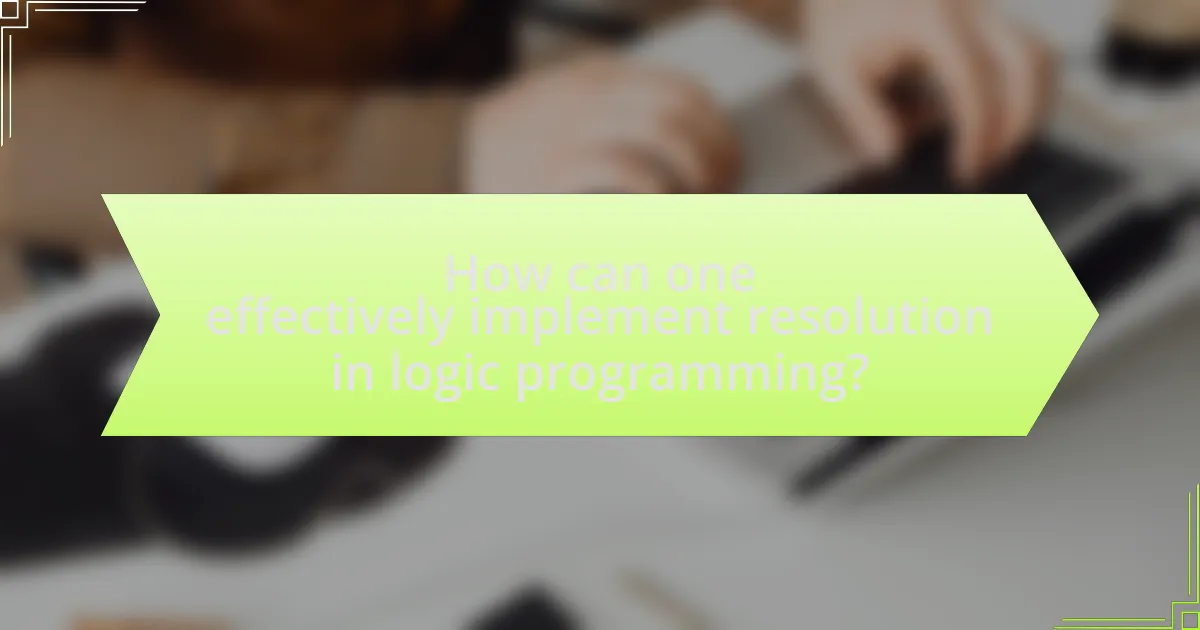
How can one effectively implement resolution in logic programming?
To effectively implement resolution in logic programming, one must utilize a systematic approach that involves transforming logical statements into a standardized form, typically Conjunctive Normal Form (CNF). This transformation allows for the application of the resolution rule, which states that from two clauses, if one contains a literal and the other contains its negation, a new clause can be derived by combining the remaining literals from both clauses.
The effectiveness of this implementation is supported by the fact that resolution is sound and complete for first-order logic, meaning that if a set of clauses is unsatisfiable, resolution will eventually derive a contradiction. Additionally, practical implementations often involve algorithms such as the Davis-Putnam algorithm or the SLD resolution, which optimize the resolution process by employing strategies like backtracking and unification. These methods have been validated through extensive use in automated theorem proving and logic programming environments, demonstrating their reliability and efficiency in deriving conclusions from logical premises.
What best practices should be followed when using resolution?
When using resolution in logic programming, best practices include ensuring the completeness of the knowledge base, maintaining consistency, and utilizing efficient algorithms for resolution. Completeness ensures that all logical consequences can be derived, which is crucial for the effectiveness of resolution. Consistency prevents contradictions within the knowledge base, which can lead to incorrect conclusions. Efficient algorithms, such as those that minimize the search space or utilize heuristics, enhance the performance of resolution processes. These practices are supported by foundational principles in logic programming, where the effectiveness of resolution is directly linked to the structure and quality of the knowledge base.
How can one optimize resolution strategies for better performance?
To optimize resolution strategies for better performance, one should implement techniques such as clause selection, indexing, and heuristic-based search. Clause selection involves prioritizing the most relevant clauses to reduce search space, while indexing allows for faster retrieval of clauses during resolution. Heuristic-based search employs strategies that guide the resolution process towards more promising paths, thereby improving efficiency. Research indicates that these methods can significantly decrease computational time and resource usage, enhancing overall performance in logic programming environments.
What common pitfalls should be avoided in resolution implementation?
Common pitfalls to avoid in resolution implementation include neglecting to ensure the completeness of the knowledge base, failing to account for variable renaming, and overlooking the importance of efficient search strategies. Neglecting completeness can lead to incomplete solutions, as the resolution process may not explore all possible paths. Variable renaming is crucial to avoid conflicts and ensure that the resolution process operates correctly; failing to do so can result in incorrect conclusions. Lastly, inefficient search strategies can significantly slow down the resolution process, making it impractical for larger problems. These pitfalls can hinder the effectiveness and efficiency of logic programming resolution.
What resources are available for learning more about resolution?
Books, online courses, and academic papers are valuable resources for learning more about resolution in logic programming. Notable books include “Logic Programming and Prolog” by Robert Kowalski, which provides foundational knowledge on resolution techniques. Online platforms like Coursera and edX offer courses specifically focused on logic programming, including resolution methods. Additionally, academic papers such as “The Resolution Principle” by John Alan Robinson, published in the Journal of the ACM, detail the theoretical underpinnings and applications of resolution in logic programming. These resources collectively enhance understanding of resolution and its significance in the field.
Where can one find comprehensive literature on resolution techniques?
Comprehensive literature on resolution techniques can be found in academic journals, textbooks, and conference proceedings focused on logic programming and artificial intelligence. Notable sources include “Logic Programming and Nonmonotonic Reasoning” by Chitta Baral, which provides in-depth coverage of resolution methods, and the journal “Artificial Intelligence,” which frequently publishes articles on advancements in resolution techniques. Additionally, the proceedings of conferences such as the International Conference on Logic Programming (ICLP) contain valuable research papers that explore various aspects of resolution in logic programming.
What online courses or tutorials are recommended for mastering resolution?
Recommended online courses for mastering resolution in logic programming include “Logic Programming and Prolog” on Coursera, which covers foundational concepts and practical applications of resolution. Additionally, “Prolog Programming for Artificial Intelligence” on edX provides in-depth tutorials on resolution techniques within Prolog, emphasizing problem-solving strategies. These courses are validated by their comprehensive curriculum and positive reviews from learners, ensuring they effectively teach resolution in the context of logic programming.
